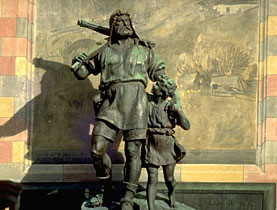Zug – the other side of the tax paradise

Think of Zug and the words "fiscal haven" immediately spring to mind. But look closer and you will see its best-kept secret – a charming, medieval heart.
A walk around the town reveals a turbulent history of wars, plundered booty and lake disasters. A far cry from today’s industrious but discretely affluent Zug.
This central Swiss town is home to 27,000 registered companies – Swiss and international – which is more than the sum of its residents – almost 24,000.
Firms such as commodities and raw materials giant Glencore and multinational Johnson & Johnson have been lured here by the low tax rates. A recent survey by Swiss bank Credit Suisse rated Zug over its big neighbour Zurich as the best location for firms and individuals.
This is not so apparent when you first arrive. “Burger King has its European headquarters here, but you won’t even find a Burger King restaurant in Zug,” says 85-year-old Sepp Keiser, Zug born and bred, and one of my guides for the day.
Much business takes place within the smart offices and malls of the new town, away from the picturesque medieval lanes of the old part just adjacent. Some companies benefit simply from having a Zug mailbox.
But what really strikes the visitor first is the town’s splendid location, on the shores of the sparkling Lake Zug. On sunny days there is a relaxed feel, as people sit outside in cafés or take in the stunning view of the snow-capped mountains from the shady promenade.
Lake disasters
But the lake, also famed for its fabulous sunsets, has not always been so benign. In March 1435 cracks started to appear in houses near the lakeside – later 26 dwellings slid into the water, killing 60 people.
In 1887 it happened again. This time the harbour wall collapsed, resulting in 11 deaths and more than 300 people losing their homes.
The problem was marl, a lime-rich mud, says Keiser. “This was very dangerous to build on,” he said. The area, now properly shored up, has been named Catastrophe Bay.
A lot of people are surprised to learn that “business” Zug has a medieval centre, and even a small 13th century castle, tucked away, says Marilyn Buchmann, an expat Englishwoman and my other guide.
The upper and lower old town, the original heart of Zug, house many gabled buildings, often with balconies and frescos, and narrow cobbled streets. The castle, once the seat of Zug’s ruling hierarchy, is now home to the city museum.
The area has been inhabited since prehistoric times. By the 12th century Zug had grown, becoming an important trading centre on the road to the St Gotthard Pass. At this time the route went over the lake.
Zug becomes wealthy
Agriculture was key and Zug’s name comes from “ziuge” or “zuige” meaning “to pull”, a term used in fishing. There is still a square named Fischmarkt, fish market.
The 16th century saw Zug’s fortunes rise considerably. “Zug became wealthy from the booty brought back from Burgundian wars,” said Buchmann.
The town started to expand, with the authorities wanting to make it the most modern city in Switzerland at the time, with straight streets.
Signs of affluence can be seen through the lavish Gothic interior of St Oswald’s Church and at the town hall, which still retains some of its original ornate woodwork.
It was also a turbulent time politically. Zug joined the Swiss Confederation in 1352, the seventh canton to do so, a fact recorded on the 52-metre Zytturm or Clock Tower which bears the coats of arms of the first eight cantons in the alliance.
In the decades that followed Zug was affected by the tensions between the Confederates and their enemies, the powerful Habsburgs.
Zurich, friend or foe?
The town also decided to remain Catholic, at a time that the Reformation, led by Zurich reformer Ulrich Zwingli, was cutting across the country.
“Zug is Catholic but don’t call them people from Inner Switzerland,” explained Keiser. “People from Zug have always felt closer to Zurich than to Lucerne.”
This didn’t stop Zurich and Zug from waging a religious war during this time. A mural on the Municipal Hall shows the two sides drinking milk soup together during a reconciliation attempt.
However, it is clear that the mural was painted much later, in 1935. As its patrons insisted on being part of it, one of the “16th century” men can be seen wearing glasses.
Present boom
Zug’s industrialisation began relatively late, only after 1850, helped by the advent of the railway linking it to Zurich.
The decision to set low tax rates – at present around half the Swiss average – was made in 1946 and marked Zug’s final move towards trade and industry.
The canton is now the richest in Switzerland.
But despite its sometimes turbulent past, it seems that small Zug has forged its own path towards prosperity and an international outlook. And, as the perfectly preserved old town shows – it has not forgotten its roots.
swissinfo, Isobel Leybold-Johnson in Zug
Inhabitants: 109,000 (around 80% Swiss, 20% foreign) – almost 24,000 in Zug.
Religions: 70% Catholic, 20% Protestant, 10% other religions or non-confessional.
Communities: 11 – Zug is the capital.
Area: c. 240 sq km.
Economic structure: 71% trade and services, 26% industry, 3% agriculture.
Around 3% of the world’s petrol is traded through Zug and neighbouring town Baar.
In an event which shocked the close-knit community in 2001, 14 local politicians were killed by a gunman. This resulted in many questioning gun use in Switzerland.
This is one of three swissinfo articles on sites taken from the new book, “Geschichte Erleben in Herzen der Schweiz” (Experiencing history in the heart of Switzerland), published by Switzerland Archaeology.
It contains 135 sites, from prehistoric times to the 20th century, from six central Swiss cantons: Lucerne, Nidwalden, Obwalden, Schwyz, Uri and Zug.
Switzerland Archaeology’s Urs Niffeler told swissinfo the idea for the book came about because there were many “hidden historical gems” that people did not know about in these regions.
The book contains short information on the site and how to get there. It currently exists in German and French and can be obtained via Swiss Archaeology.

In compliance with the JTI standards
More: SWI swissinfo.ch certified by the Journalism Trust Initiative










You can find an overview of ongoing debates with our journalists here . Please join us!
If you want to start a conversation about a topic raised in this article or want to report factual errors, email us at english@swissinfo.ch.